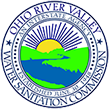ORSANCO operates four datasondes with telemetry systems. The systems are located at Pike Island Locks and Dam, Meldahl Locks and Dam, Markland Locks and Dam, and Newburgh Locks and Dam. Sensors on these datasondes collect pH, Conductivity, Turbidity, Dissolved Oxygen, Temperature, and Chlorophyll a data every 30 minutes. Data is collected during the primary HAB season.
For more information on Harmful Algae Blooms, please contact Greg Youngstrom.
2019 Ohio River Harmful Algae Bloom
During September to October, 2019, ORSANCO worked closely with Ohio, Indiana and Kentucky to monitor an algae bloom in the Ohio River, in the Cincinnati / Northern Kentucky area. ORSANCO coordinated sample collection and lab analysis with member states.
Ohio, Kentucky and Indiana issued recreation advisories or cautionary statements for recreation on the Ohio River. After the bloom ended, these recreation advisories and cautionary statements were lifted.
One hundred fifty one (151) samples were collected and analyzed for the toxin microcystin. Finished drinking water was sampled by either the water utilities or state personnel. No toxins were detected in finished drinking water. Click here to view the 2019 sampling results.
2015 Ohio River Harmful Algae Bloom
During August to October, 2015, ORSANCO worked closely with Ohio, West Virginia, Indiana and Kentucky to monitor an algae bloom in the Ohio River. ORSANCO coordinated sample collection and lab analysis with member states.
Ohio, West Virginia, Kentucky and Indiana issued recreation advisories for the Ohio River. Illinois issued a cautionary statement concerning recreation in the river due to concern that the bloom would reach the state border. After the bloom ended, these recreation advisories and cautionary statements were lifted.
ORSANCO collected 150 samples from the Ohio River, which were analyzed for the toxin microcystin. Finished drinking water was sampled by either the water utilities or state personnel. No toxins were detected in finished drinking water. Click here to view 2015 sampling results.

